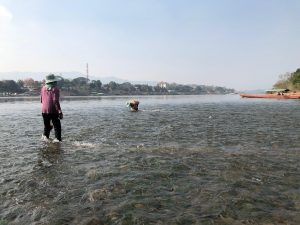Water levels on the Mekong River have fallen due to the filling of a Chinese dam on the upper reaches of the river in Yunnan province, according to locals and river monitors.
The fall was reported on January 4, when locals in the Thai port town of Chiang Saen, close to the Golden Triangle confluence with Laos and Myanmar, started sharing photos on social media showing a sudden and unexpected drop in the water level along the river.
The drop was quickly confirmed by the recently-launched Mekong Dam Monitor, which employs remote sensing and data from satellites to track water levels along mainland Southeast Asia’s great river.
The Mekong Dam Monitor, which is operated by the Washington-based Stimson Center and the American research firm Eyes on Earth, and is part-funded by the U.S. State Department, was officially launched on December 15.
Satellite photos of the Mekong at Chiang Saen posted online by Brian Eyler, head of the Southeast Asia Program at the Stimson Center, show a visible drop in water levels between January 1 and 4, leaving sections of the river bed exposed.
Eyler wrote that in the last week of December, Chinese dam engineers began filling the reservoir of the Jinghong dam, the southernmost of the 11 large dams that China has built on its stretch of the river, which it refers to as the Lancang.
According to Eyler, the Mekong Dam Monitor estimated the drop at more than 1 meter, noting that China’s river gauge at Yunjinghong, which is located just downstream of the Jinghong dam, showed a similar drop beginning on December 31.
Pianporn Deetes, the campaigns director for Thailand and Myanmar for the global NGO International Rivers, told The Diplomat that according to contacts in Chiang Saen, the river’s water level dropped from 2.85 meters on January 2, to 1.94 meters two days later.
She said that Chinese dams had been causing sudden falls and surges in the Mekong’s water levels for nearly two decades without attracting much international attention. (China’s first Lancang dam went online in 1995.)
But over the past year, the impact of China’s upstream dams have become the subject of increasing international attention. In April, Eyes on Earth published a study claiming that Chinese dam reservoirs had held back excess monsoon rains, exacerbating historic drought conditions in downstream nations, where more than 66 million people rely on the Mekong and its resources. The report’s findings have since been taken up by the U.S. government in an attempt to turn regional opinion against China.
The Chinese government has rejected the report’s findings, asserting its own research that water stored in reservoirs during the flood season has actually helped prevent both downstream floods and droughts. (In 2019, the Chinese Embassy in Thailand released a statement claiming that “upstream water dams play an important role by storing water in the wet season for discharge in the dry season.”) At the same time, Beijing has promised to share hydrological data with downstream nations in order to assuage their concerns about the river’s health.
Yet according to Eyler, China “sent no notification to downstream countries” about the filling of the Jinghong dam that began on December 31. It is also unclear whether it notified the Mekong River Commission, which counts Thailand, Vietnam, Laos, and Cambodia as members, and is an important forum for dealing with crossborder river management.
Pianporn of International Rivers said that China’s apparent actions undermined its pledge of transparency. “Promises on data sharing with downstream countries will be empty without sincere political will among China and downstream riparian countries to accept and mitigate exiting environmental destruction of the Mekong River, and increase participatory management of regionally shared resources,” she said.
“Most importantly,” she added, “this includes changing the ways these dams are operated.”

































